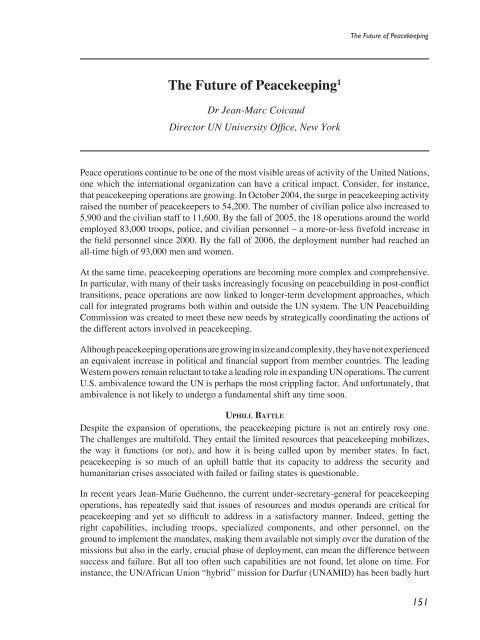Defence Forces Review 2008
Defence Forces Review 2008
Defence Forces Review 2008
You also want an ePaper? Increase the reach of your titles
YUMPU automatically turns print PDFs into web optimized ePapers that Google loves.
The Future of Peacekeeping<br />
The Future of Peacekeeping 1<br />
Dr Jean-Marc Coicaud<br />
Director UN University Office, New York<br />
Peace operations continue to be one of the most visible areas of activity of the United Nations,<br />
one which the international organization can have a critical impact. Consider, for instance,<br />
that peacekeeping operations are growing. In October 2004, the surge in peacekeeping activity<br />
raised the number of peacekeepers to 54,200. The number of civilian police also increased to<br />
5,900 and the civilian staff to 11,600. By the fall of 2005, the 18 operations around the world<br />
employed 83,000 troops, police, and civilian personnel – a more-or-less fivefold increase in<br />
the field personnel since 2000. By the fall of 2006, the deployment number had reached an<br />
all-time high of 93,000 men and women.<br />
At the same time, peacekeeping operations are becoming more complex and comprehensive.<br />
In particular, with many of their tasks increasingly focusing on peacebuilding in post-conflict<br />
transitions, peace operations are now linked to longer-term development approaches, which<br />
call for integrated programs both within and outside the UN system. The UN Peacebuilding<br />
Commission was created to meet these new needs by strategically coordinating the actions of<br />
the different actors involved in peacekeeping.<br />
Although peacekeeping operations are growing in size and complexity, they have not experienced<br />
an equivalent increase in political and financial support from member countries. The leading<br />
Western powers remain reluctant to take a leading role in expanding UN operations. The current<br />
U.S. ambivalence toward the UN is perhaps the most crippling factor. And unfortunately, that<br />
ambivalence is not likely to undergo a fundamental shift any time soon.<br />
Up h i l l Ba t t l e<br />
Despite the expansion of operations, the peacekeeping picture is not an entirely rosy one.<br />
The challenges are multifold. They entail the limited resources that peacekeeping mobilizes,<br />
the way it functions (or not), and how it is being called upon by member states. In fact,<br />
peacekeeping is so much of an uphill battle that its capacity to address the security and<br />
humanitarian crises associated with failed or failing states is questionable.<br />
In recent years Jean-Marie Guéhenno, the current under-secretary-general for peacekeeping<br />
operations, has repeatedly said that issues of resources and modus operandi are critical for<br />
peacekeeping and yet so difficult to address in a satisfactory manner. Indeed, getting the<br />
right capabilities, including troops, specialized components, and other personnel, on the<br />
ground to implement the mandates, making them available not simply over the duration of the<br />
missions but also in the early, crucial phase of deployment, can mean the difference between<br />
success and failure. But all too often such capabilities are not found, let alone on time. For<br />
instance, the UN/African Union “hybrid” mission for Darfur (UNAMID) has been badly hurt<br />
151
















